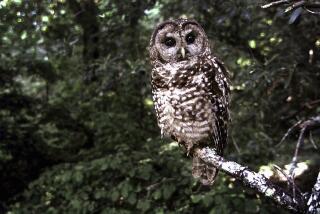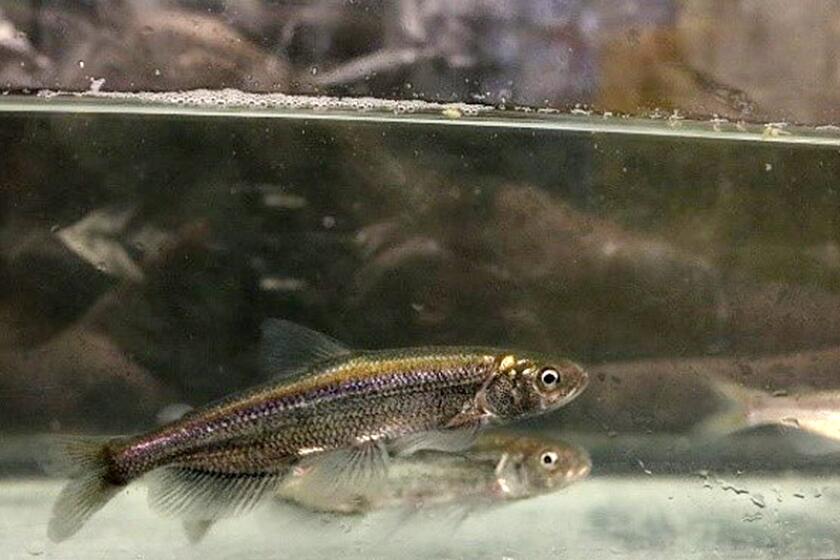Endangered Bird Stymies Builders in Orange County
- Share via
In a move with broad implications for future growth, federal wildlife officials have begun denying permits to some southern Orange County landowners who are seeking to clear plots of land containing rare California gnatcatchers.
A few landowners recently learned that they cannot immediately grade single-family lots because of uncertainty, given the current building boom, over how many of the federally protected birds still reside in the region.
The federal delays come as a reminder of how development is tied to the welfare of a tiny bird that mews like a kitten and dwells on some of the nation’s most desirable and expensive coastal real estate.
Significant building delays could be possible if developers, government officials and environmentalists fail to proceed with a landmark program creating wildlife preserves in Orange County and elsewhere in the region.
“It’s frustrating to see this process grinding its gears like this,” said conservation biologist Dennis Murphy, a key player in crafting the program in the early 1990s.
The extent of the problem won’t be known for several weeks, when the U.S. Fish and Wildlife Service completes a study of the local gnatcatcher population.
Number of Birds Is Critical
Under the best scenario for birds and builders alike, the review could find so many gnatcatchers that regulators can resume issuing permits. But if regulators find that the gnatcatcher’s future is imperiled, they could be forced to choose a more time-consuming permitting process, slowing the rate of south Orange County development until a special nature preserve is completed.
Officials aren’t sure which projects could be slowed, but county officials have drawn up a list of projects that could disrupt gnatcatchers or their habitat before the preserve is in place. That list, requested by the Fish and Wildlife Service to better understand the problem, includes two car dealerships, homes in Coto de Caza, the controversial Saddleback Meadows housing project, and the 434-home Marblehead development in San Clemente.
“We need to ask ourselves again, ‘Are we giving too much? Is it jeopardizing the species?’ ” said John Bradley, the service’s supervising biologist for Orange and Los Angeles counties.
Construction of several major housing projects in the San Clemente area may have exhausted the number of southern Orange County gnatcatchers allowed to be harmed or disturbed under the 1993 compromise.
That agreement was supposed to be merely a temporary measure. It permitted limited land development and gnatcatcher losses while wilderness preserves were designed to protect rare species.
But more than five years later, creation of a planned 40,000-acre-plus south Orange County preserve is lagging far behind schedule, stretching the limits of the temporary rules. Although county officials overseeing the reserve’s creation predicted in May that a draft reserve design could be ready by July, some say a draft may not materialize until late this year.
In the meantime, small landowners have been caught in the squeeze.
Already, landowners attempting to build homes in Coto de Caza have found themselves entangled in endangered species red tape, and more permits are in the pipeline.
The property owners are “in shock. I hear from some of them that it’s the first time they’ve heard there are gnatcatchers out there,” said Gary Medeiros, county chief of resource planning. “They’re not large companies, and they can’t afford to be overextended like this. . . . They’re a bit upset with the whole situation, and I don’t blame them.”
Medeiros and Fish and Wildlife officials are working to design short-term solutions so that the Coto de Caza landowners can build their homes. But a larger question remains: What will the federal agency decide when it completes its review of the gnatcatcher’s well-being throughout Southern California?
The current debate is rekindling memories of the early 1990s, when the impending listing of the tiny gnatcatcher on the federal endangered species list sparked a regional development debate.
The gnatcatcher lives in coastal sage scrub, a mix of plants that once blanketed the coastal hills of Southern California. Today, with 90% of sage scrub areas developed, it ranks as one of the most endangered habitats in the United States.
Under the guidelines, no more than 5% of the coastal sage scrub or 5% of the gnatcatcher population were to be destroyed during the reserve planning process.
Coastal Shrub Clearing Continues
About 560 pairs of gnatcatchers remained in south Orange County this spring, federal biologists said. The guidelines allowed for 19 pairs--or 38 birds--to be harmed by development in that area. But the permits for several recent developments allowed for 58 gnatcatchers to be removed or destroyed.
Federal regulators are reviewing how many gnatcatchers now live in the region, and if further building would jeopardize their survival.
That study is legally required because federal tallies showed that the number of harmed gnatcatchers was near or at the limit. Until the study is completed in late September or early October, officials said, they will hold off on issuing new permits for clearing areas inhabited by the songbird. They are continuing to allow clearing of bird-free coastal sage scrub.
Some finger-pointing is accompanying the current gnatcatcher snafu.
County planning administrator Tim Neely called the small landowners’ plight a “procedural crisis,” and he criticized the Fish and Wildlife Service for not moving more quickly to craft a solution after issuing a flurry of permits to major developers in February.
“I don’t know why it’s taken as long as it is,” Neely said.
That’s exactly what some federal regulators and environmentalists are saying about the long-delayed plan for a reserve in southern Orange County, which many consider the panacea for the current gnatcatcher problems. That reserve is being designed under county oversight in tandem with Rancho Mission Viejo LLC, southern Orange County’s largest landowner.
A rare public meeting on that plan brought a standing-room-only crowd of more than 200 people to a San Clemente school auditorium in May. Many voiced concerns about the impact of new development on what some call “the lost wilderness,” a huge expanse of open land largely owned by Rancho Mission Viejo Co. and brimming with rare plants and animals such as the gnatcatcher.
“They had that public meeting, but nothing’s happened,” said Dan Silver, coordinator of the Endangered Habitats League, a conservation group.
Diane Gaynor, spokeswoman for the Rancho Mission Viejo, disputed the notion that preserve planning is behind schedule. Instead, talks have expanded to include wetlands preservation as part of the preserve design, she said.
“We’re still committed . . . to that process,” she said.
(BEGIN TEXT OF INFOBOX / INFOGRAPHIC)
California Gnatcatcher
Status: Federal endangered species
Population: About 3,200 pairs in Southern California; about 560 pair in south Orange County (1996 figures)
Size: 4 inches
Markings: Blue-gray with a long black tail
Habitat: Coastal sage scrub, a mix of sagebrush and grasses found in Orange, San Diego, western Riverside, Los Angeles and San Bernardino counties
Sources: Orange County Environmental Management Agency, U.S. Fish and Wildlife Service
More to Read
Sign up for Essential California
The most important California stories and recommendations in your inbox every morning.
You may occasionally receive promotional content from the Los Angeles Times.










